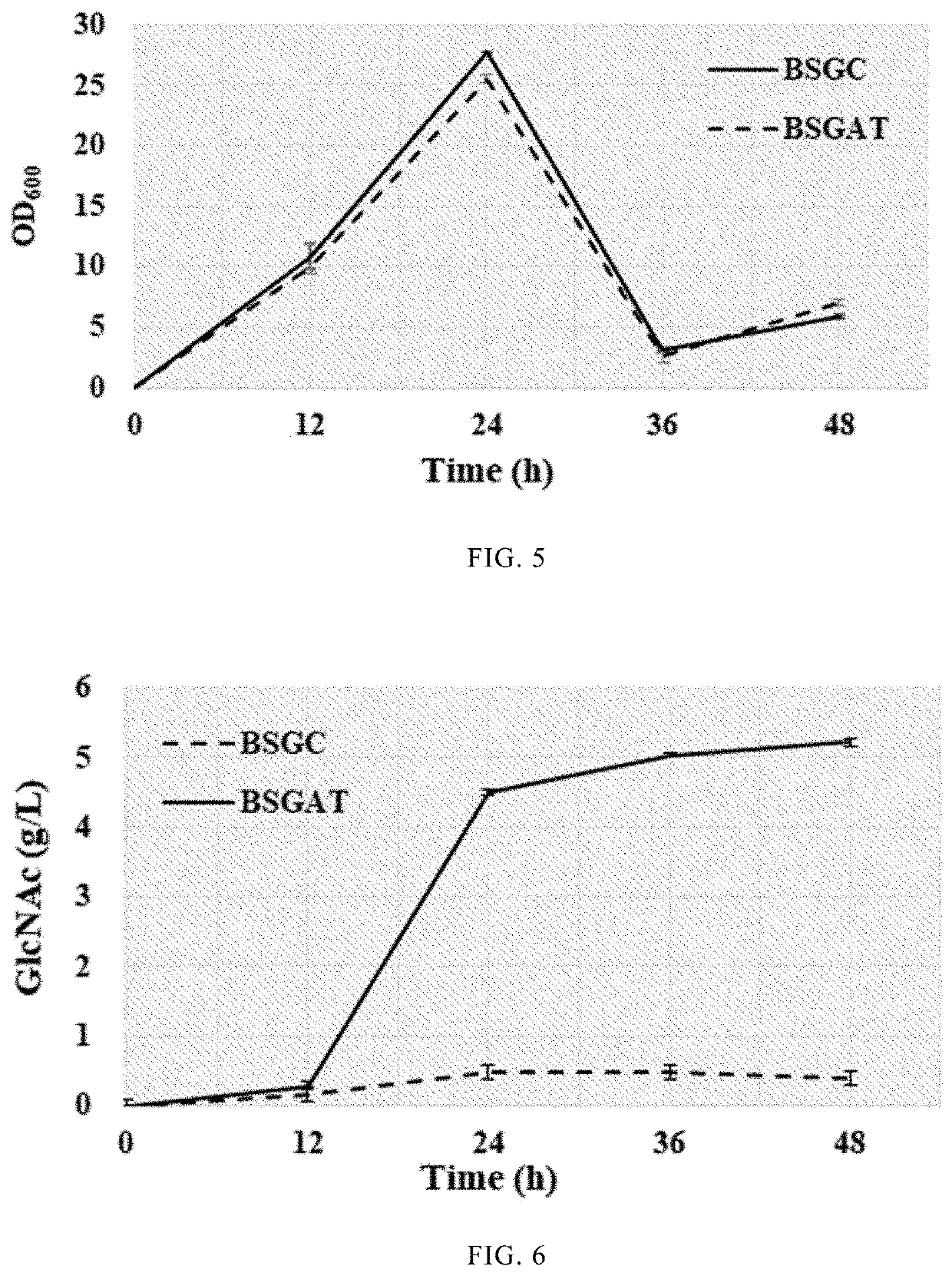Recombinant Bacillus subtilis and use thereof
a technology of bacillus subtilis and recombinant bacillus subtilis, which is applied in the field of recombinant bacillus subtilis and construction methods, can solve the problems of heavy cell metabolic burden, unsuitable for people with seafood, and serious to the environment, and achieves the effects of reducing the metabolic burden of cells, facilitating the transportation of products, and efficiently synthesizing glcna
- Summary
- Abstract
- Description
- Claims
- Application Information
AI Technical Summary
Benefits of technology
Problems solved by technology
Method used
Image
Examples
embodiment 1
Verification of FMMs of Bacillus subtilis as a Stable Space Scaffold
[0039]Based on Bacillus subtilis BSGN6, a fusion gene expression cassette of FloT and green fluorescent protein EGFP was integrated at the floT site (NCBI-Gene ID: 937138) of scaffold protein coding gene of Bacillus subtilis BSGN6 genome. An integration site floT sequence (1 kb in length, the C-terminal termination codon being removed), an EGFR gene sequence (0.7 kb in length, the nucleotide sequence being shown as SEQ ID NO.2), a zeocin resistant gene (the nucleotide sequence being shown as SEQ ID NO.3), and a FloT downstream (1 kb in length) were used to construct the integration cassette. The amplified FloT-EGFP fusion expression cassette was transformed into the strain BSGN6 by homologous recombination, and transformants were selected on LB plate with zeocin. Positive transformants with FloT-EGFP fusion expression were further verified by colony PCR with primers FloT-EGFP-F (GCTGATATCGCAACAGCAGAG) / FloT-EGFP-R (C...
embodiment 2
Verification of Bacillus subtilis Scaffold Protein FloA and FloT Located in the Same FMMs
[0042]Based on Bacillus subtilis BSGN6, a fusion gene expression cassette of FloA and green fluorescent protein EGFP was integrated at the floA site (NCBI-Gene ID: 937865) of scaffold protein coding gene of Bacillus subtilis BSGN6 genome. An integration site floA sequence (1 kb in length, the C-terminal termination codon being removed), an EGFR gene sequence (0.7 kb in length, the nucleotide sequence being shown as SEQ ID NO.2), a chloromycetin resistant gene (the nucleotide sequence being shown as SEQ ID NO.4), and a FloA downstream (1 kb in length) were used to construct the integration cassette. The amplified FloA-EGFP fusion expression cassette was transformed into the strain BSGN6 by homologous recombination, and transformants were selected on LB plate with chloromycetin. Positive transformants with FloA-EGFP fusion expression were further verified by colony PCR with primers FloA-EGFP-F (GC...
embodiment 3
[0046]Verify that the SPFH domain was responsible for FMMs location
[0047]It was known that flotillin-like scaffold proteins generally consist of two domains, the N-terminal SPFH domain and the C-terminal flotillin domain. To identify which domain is responsible for protein localization, the sequence of FloT protein was divided into SPFH domain (1-220 aa) and flotillin domain (221-510 aa) by bioinformatics analysis and the strains expressing a C-terminal EGFP fusion to the full length FloT, SPFH domain and flotillin domain were generated using the pP43NMK plasmid. As shown in FIG. 3, laser scanning confocal microscopy and fluorescence intensity 3D analysis revealed that the fluorescence signal of SPFH domain was mainly located at the plasma membrane, similar to that of full length FloT, suggesting that the SPFH domain of FloT is responsible for protein localization to FMMs.
PUM
| Property | Measurement | Unit |
|---|---|---|
| time | aaaaa | aaaaa |
| concentration | aaaaa | aaaaa |
| catalytic efficiency | aaaaa | aaaaa |
Abstract
Description
Claims
Application Information
 Login to View More
Login to View More - R&D
- Intellectual Property
- Life Sciences
- Materials
- Tech Scout
- Unparalleled Data Quality
- Higher Quality Content
- 60% Fewer Hallucinations
Browse by: Latest US Patents, China's latest patents, Technical Efficacy Thesaurus, Application Domain, Technology Topic, Popular Technical Reports.
© 2025 PatSnap. All rights reserved.Legal|Privacy policy|Modern Slavery Act Transparency Statement|Sitemap|About US| Contact US: help@patsnap.com



